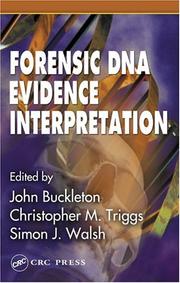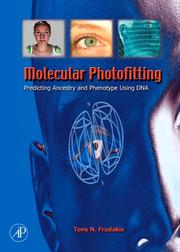| Listing 1 - 10 of 222 | << page >> |
Sort by
|
Book
ISBN: 9780521519434 9780511778193 Year: 2010 Publisher: Cambridge ; New York : Cambridge University Press,
Abstract | Keywords | Export | Availability | Bookmark
 Loading...
Loading...Choose an application
- Reference Manager
- EndNote
- RefWorks (Direct export to RefWorks)
"The introduction of DNA profiling and databasing into the criminal justice system, which began in 1988, when English baker Colin Pitchfork was the first person convicted through the use of DNA evidence (Sanders 2000C001-001)"--
Book
ISBN: 1772032476 9781772032475 9781772032505 1772032506 9781772032505 Year: 2019 Publisher: Victoria ; Vancouver ; Calgary : Heritage,
Abstract | Keywords | Export | Availability | Bookmark
 Loading...
Loading...Choose an application
- Reference Manager
- EndNote
- RefWorks (Direct export to RefWorks)
"An investigative reporter traces the role of DNA evidence in two groundbreaking murder cases involving young girls killed two decades apart in the same town. In 1977, the industrial town of Port Alberni was shaken by the brutal murder of twelve-year-old Carolyn Lee, who had been abducted while walking home from her dance class. In 1996, the town was devastated again when eleven-year-old Jessica States disappeared while chasing foul balls at a local fast-pitch game, her lifeless body later found beaten in the woods. At the time of States's murder, Shayne Morrow was working as a reporter for the Alberni Valley Times. His interest in forensic science led him to cover the States case and relate it back to the Lee case, which had gone unsolved for years. In his coverage, Morrow gained unprecedented access to the investigators and scientists who were on the trail of both killers. Emerging DNA technology in the mid-1990s led to a renewed interest in the Lee case and ultimately to the conviction of her killer, Gurmit Singh Dhillon, in 1998. The technological mechanisms put in place during that case would lay the groundwork for the capture of States's killer, Roderick Patten, a year later. The Bulldog and the Helix is a riveting portrait of a town rocked twice by the most heinous type of crime imaginable and a community's unrelenting search for justice."--
Book
Year: 2005 Publisher: Washington, DC : Departamento de Justicia de Estados Unidos, Oficina de Programas de Justicia : Iniciativa del ADN del Presidente,
Abstract | Keywords | Export | Availability | Bookmark
 Loading...
Loading...Choose an application
- Reference Manager
- EndNote
- RefWorks (Direct export to RefWorks)
Book
Abstract | Keywords | Export | Availability | Bookmark
 Loading...
Loading...Choose an application
- Reference Manager
- EndNote
- RefWorks (Direct export to RefWorks)
Book
ISBN: 0429671423 0429672918 0429001010 Year: 2019 Publisher: Milton : CRC Press LLC,
Abstract | Keywords | Export | Availability | Bookmark
 Loading...
Loading...Choose an application
- Reference Manager
- EndNote
- RefWorks (Direct export to RefWorks)
DNA testing and its forensic analysis are recognized as the gold standard in forensic identification science methods. However, there is a great need for a hands-on step-by-step guide to teach the forensic DNA community how to interpret DNA mixtures, how to assign a likelihood ratio, and how to use the subsequent likelihood ratio when reporting interpretation conclusions. Forensic DNA Profiling: A Practical Guide to Assigning Likelihood Ratios will provide a roadmap for labs all over the world and the next generation of analysts who need this foundational understanding. The techniques used in forensic DNA analysis are based upon the accepted principles of molecular biology. The interpretation of a good-quality DNA profile generated from a crime scene stain from a single-source donor provides an unambiguous result when using the most modern forensic DNA methods. Unfortunately, many crime scene profiles are not single source. They are described as mixed since they contain DNA from two or more individuals. Interpretation of DNA mixtures represents one of the greatest challenges to the forensic DNA analyst. As such, the book introduces terms used to describe DNA profiles and profile interpretation. Chapters explain DNA extraction methods, the polymerase chain reaction (PCR), capillary electrophoresis (CE), likelihood ratios (LRs) and their interpretation, and population genetic models--including Mendelian inheritance and Hardy-Weinberg equilibrium. It is important that analysts understand how LRs are generated in a probabilistic framework, ideally with an appreciation of both semicontinuous and fully continuous probabilistic approaches. KEY FEATURES:The first book to focus entirely on DNA mixtures and the complexities involved with interpreting the results Takes a hands-on approach offering theory with worked examples and exercises to be easily understood and implementable by laboratory personnel New methods, heretofore unpublished previously, provide a means to innovate deconvoluting a mixed DNA profile, assign an LR, and appropriately report the weight of evidence Includes a chapter on assigning LRs for close relatives (i.e., It's not me, it was my brother), and discusses strategies for the validation of probabilistic genotyping software Forensic DNA Profiling fills the void for labs unfamiliar with LRs, and moving to probabilistic solutions, and for labs already familiar with LRs, but wishing to understand how they are calculated in more detail. The book will be a welcome read for lab professionals and technicians, students, and legal professionals seeking to understand and apply the techniques covered.
Book
ISBN: 0197561225 1280471182 9786610471188 1602562644 Year: 1992 Publisher: New York : W.H. Freeman,
Abstract | Keywords | Export | Availability | Bookmark
 Loading...
Loading...Choose an application
- Reference Manager
- EndNote
- RefWorks (Direct export to RefWorks)
DNA fingerprinting --- DNA fingerprinting. --- Forensic genetics --- Technique.

ISBN: 0849330173 Year: 2005 Publisher: Boca Raton (Fla.) : CRC press,
Abstract | Keywords | Export | Availability | Bookmark
 Loading...
Loading...Choose an application
- Reference Manager
- EndNote
- RefWorks (Direct export to RefWorks)
Multi
ISBN: 9780128205686 0128205687 9780128205624 0128205628 Year: 2020 Publisher: London, England : Academic Press,
Abstract | Keywords | Export | Availability | Bookmark
 Loading...
Loading...Choose an application
- Reference Manager
- EndNote
- RefWorks (Direct export to RefWorks)

ISBN: 9780120884926 0120884925 9780080551371 0080551378 1281038121 9781281038128 9786611038120 6611038124 Year: 2008 Publisher: Amsterdam ; Boston : Elsevier Academic Press,
Abstract | Keywords | Export | Availability | Bookmark
 Loading...
Loading...Choose an application
- Reference Manager
- EndNote
- RefWorks (Direct export to RefWorks)
In the field of forensics, there is a critical need for genetic tests that can function in a predictive or inferential sense, before suspects have been identified, and/or for crimes for which DNA evidence exists but eye-witnesses do not. Molecular Photofitting fills this need by describing the process of generating a physical description of an individual from the analysis of his or her DNA. The molecular photofitting process has been used to assist with the identification of remains and to guide criminal investigations toward certain individuals within the sphere of prior suspects.
Book
Year: 2012 Publisher: Washington, D.C. : U.S. Dept. of Justice, National Institute of Justice,
Abstract | Keywords | Export | Availability | Bookmark
 Loading...
Loading...Choose an application
- Reference Manager
- EndNote
- RefWorks (Direct export to RefWorks)
| Listing 1 - 10 of 222 | << page >> |
Sort by
|

 Search
Search Feedback
Feedback About UniCat
About UniCat  Help
Help News
News